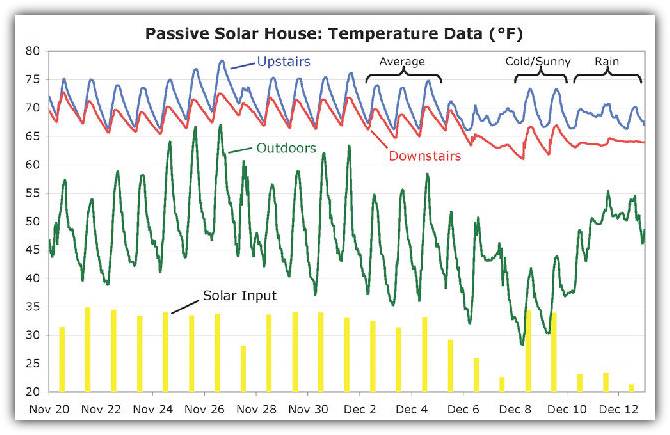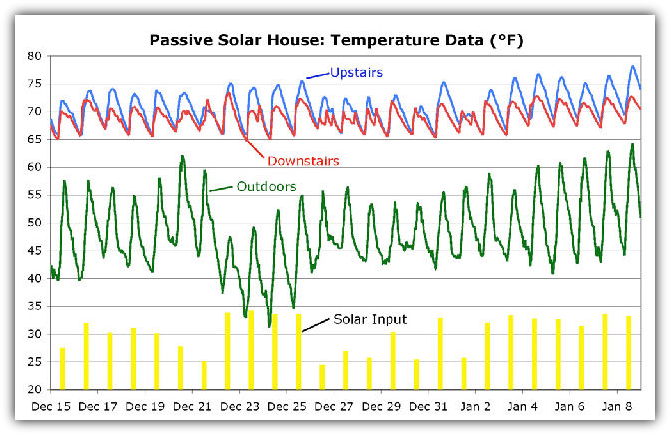
Randy Knight: Our Passive - Solar Straw Bale House & Its Performance Data - Atascadero, CA

Architect: Jennifer Rennick
Architect. Certified Energy Analyst. InBalance Consulting.
2410 Leona Avenue, San Luis Obispo CA 93401 805.423.8359
email jennifer@inbalancegreen.com www.inbalancegreen.com www.losaltospassivesolar.com
A graduate of California Polytechic State University, San Luis Obispo
Architect. Certified Energy Analyst. InBalance Consulting.
2410 Leona Avenue, San Luis Obispo CA 93401 805.423.8359
email jennifer@inbalancegreen.com www.inbalancegreen.com www.losaltospassivesolar.com
A graduate of California Polytechic State University, San Luis Obispo
Randy Knight Professor of Physics, California Polytechnic State University
805.756.1663 805.756.2435 fax rknight@calpoly.edu
805.756.1663 805.756.2435 fax rknight@calpoly.edu
Builder: Semmes & Co., Atascadero CA
Completion Date: July 2009
Completion Date: July 2009
The house was sited facing nearly due south (about 20° east of due south), with most windows and sliding-glass doors on the south side to capture energy from the sun when it is low in the sky in winter. Getting the right coatings on the windows was an important and nontrivial issue for which I'll add notes later.) During summer, with the sun high in the sky, overhangs keep the interior almost totally shaded. The goal of passive solar heating is to slowly heat the large thermal mass of the concrete floors (downstairs), tile floors (upstairs), and the bale walls, then let that captured energy keep the house warm overnight.
To test how well this is working, we conveniently were out of town for 3 weeks in late November and early December. Other than a pet sitter coming in once a day, the house was just sitting there doing it's thing. Supplemental heat (more on that later) was turned off downstairs. Upstairs, baseboard heater thermostats were left at 65°. Three data loggers – one upstairs, one downstairs, and one outdoors – recorded the temperature every 30 minutes for 23 days. Although I plan later to install a pyranometer to measure actual solar energy coming through the windows, for the time being I'm using the daily production of the PV panels as a proxy for solar input.
Here are the results:
To test how well this is working, we conveniently were out of town for 3 weeks in late November and early December. Other than a pet sitter coming in once a day, the house was just sitting there doing it's thing. Supplemental heat (more on that later) was turned off downstairs. Upstairs, baseboard heater thermostats were left at 65°. Three data loggers – one upstairs, one downstairs, and one outdoors – recorded the temperature every 30 minutes for 23 days. Although I plan later to install a pyranometer to measure actual solar energy coming through the windows, for the time being I'm using the daily production of the PV panels as a proxy for solar input.
Here are the results:

It was mostly sunny for the 23 days of data. During a sunny stretch, the indoor temperatures more-or-less tracks the daily outdoor high temperature. For example, Nov 23-26 were 4 days of steadily increasing temperatures, and the indoor temps similarly increased day by day over this period. The downstairs temperature oscillates 4 to 5 degrees a day on sunny days, peaking at 1:00 p.m. The upstairs temperature has a larger oscillation, more like 7 degrees, since it has heat loss through the roof as well as less wall insulation than the bales provide downstair. The later peak, at 3:00 p.m., is likely due to a west window in my study getting reasonably good afternoon sun.
Temperatures were running above seasonal norms for the first 12 days, but the 3 days marked as "Average," Dec 2-4, were sunny days at very close to seasonal temperature norms of mid-30s to mid-50s. During these average winter conditions, the downstairs temperature oscillated 65-70 degrees while upstairs was 67-74. Had we been home, we probably would have turned the downstairs gas fireplace on for an hour or two in the morning, but basically the house is maintaining a comfortable temperature range from solar heating alone in normal conditions. Because of the lack of drafts, with the house tightly sealed, it's quite comfortable at 68 or 69 degrees.
Dec 8-9 are a more stringent test. These were the two coldest days of the season so far – below freezing mornings and with highs only in the low 40s – and that followed a cloudy day on Dec 7 that provided no solar heating. With the outdoor temperature at 28, downstairs dropped to 61 - but bounced back to 67 on both days when sun came out. Upstairs, it looks like the baseboard heater came on - notice how the minima are rounded rather than the much sharper minima earlier in the record when the baseboard heater was not coming on - but the upstairs recovered nicely to 73 on both days. So even on days about as cold as it gets here, only a small amount of supplement heat is going to be needed as long as its sunny.
But the sun doesn't always shine. The last three days of the record were totally cloudy and rainy. Even though the outdoor temperature wasn't too bad - averaging about 50 - downstairs settled to a fairly steady 64 degrees. Upstairs had more variation but averaged about 67. It probably would have gone lower without the baseboard heater kicking in a couple of times. It looks like we'll need a fairly steady use of the supplemental heat sources when we get extended cloudy/rainy weather
Temperatures were running above seasonal norms for the first 12 days, but the 3 days marked as "Average," Dec 2-4, were sunny days at very close to seasonal temperature norms of mid-30s to mid-50s. During these average winter conditions, the downstairs temperature oscillated 65-70 degrees while upstairs was 67-74. Had we been home, we probably would have turned the downstairs gas fireplace on for an hour or two in the morning, but basically the house is maintaining a comfortable temperature range from solar heating alone in normal conditions. Because of the lack of drafts, with the house tightly sealed, it's quite comfortable at 68 or 69 degrees.
Dec 8-9 are a more stringent test. These were the two coldest days of the season so far – below freezing mornings and with highs only in the low 40s – and that followed a cloudy day on Dec 7 that provided no solar heating. With the outdoor temperature at 28, downstairs dropped to 61 - but bounced back to 67 on both days when sun came out. Upstairs, it looks like the baseboard heater came on - notice how the minima are rounded rather than the much sharper minima earlier in the record when the baseboard heater was not coming on - but the upstairs recovered nicely to 73 on both days. So even on days about as cold as it gets here, only a small amount of supplement heat is going to be needed as long as its sunny.
But the sun doesn't always shine. The last three days of the record were totally cloudy and rainy. Even though the outdoor temperature wasn't too bad - averaging about 50 - downstairs settled to a fairly steady 64 degrees. Upstairs had more variation but averaged about 67. It probably would have gone lower without the baseboard heater kicking in a couple of times. It looks like we'll need a fairly steady use of the supplemental heat sources when we get extended cloudy/rainy weather

New results, January 20, 2010:
The graph below shows 25 more days, starting a few days after the previous graph ended. We were home the entire period and using supplemental heat as needed.
The graph below shows 25 more days, starting a few days after the previous graph ended. We were home the entire period and using supplemental heat as needed.
Downtairs supplemental heat consists primarily of a gas fireplace that use 35,000 BTU/hr = 10.3 kW to provide 26,000 BTU/hr = 7.6 kW to the great room. (We do have in-floor hydronic heating in the library, but I have the thermostat low enough for it not to come on, and also in the master bedroom. The bedroom heating came on only a couple of times during this period, and in any case the bedroom is thermally well isolated from the great room where the downstairs temperature is recorded.) During most of this period, the fireplace was turned on for a couple of hours every morning (roughly 20 kWh of energy used) to quickly warm the downstairs from 65° or 66° to about 69°, then the sun took over. On cloudy days, the fireplace was used again in later afternoon and early evening. However, this was a stretch of days with above-average temperatures. The average for these 25 days (which should have been about the coldest of winter) was 48°, compared to a 47° average during the 23 days from late November to early December.
Upstairs supplemental heating consists of a 1500 W electric baseboard heater in my study and a 2000 W electric baseboard heater in Sally's studio. Although using electricity for heating, rather than gas, is usually a really poor choice from an energy perspective, we chose electric over gas on the premise that we've sized the PV system to make us electrically neutral over the course of a year. However, with the upstairs being more thermally lossy than downstairs, the baseboard heaters seem to have been running more than I expected and are the major contributor to the big spike in electricity use in December. (See the PV page here.) Being electrically neutral is looking less likely.
Bottom line: With some supplemental heat, probably a bit more than I counted on but vastly less than in a conventional house, we can keep the passive solar house comfortable at all times. Notice the 5 days at the end of the record which were sunny and relatively mild and where we used only a very little bit of early morning heat from the fireplace.
Coming up: Colder and cloudy in mid-January. I'm starting to read the gas and electric meters every day in an effort to better quantify our supplemental energy use. Hope to report on that sometime in February.
Upstairs supplemental heating consists of a 1500 W electric baseboard heater in my study and a 2000 W electric baseboard heater in Sally's studio. Although using electricity for heating, rather than gas, is usually a really poor choice from an energy perspective, we chose electric over gas on the premise that we've sized the PV system to make us electrically neutral over the course of a year. However, with the upstairs being more thermally lossy than downstairs, the baseboard heaters seem to have been running more than I expected and are the major contributor to the big spike in electricity use in December. (See the PV page here.) Being electrically neutral is looking less likely.
Bottom line: With some supplemental heat, probably a bit more than I counted on but vastly less than in a conventional house, we can keep the passive solar house comfortable at all times. Notice the 5 days at the end of the record which were sunny and relatively mild and where we used only a very little bit of early morning heat from the fireplace.
Coming up: Colder and cloudy in mid-January. I'm starting to read the gas and electric meters every day in an effort to better quantify our supplemental energy use. Hope to report on that sometime in February.